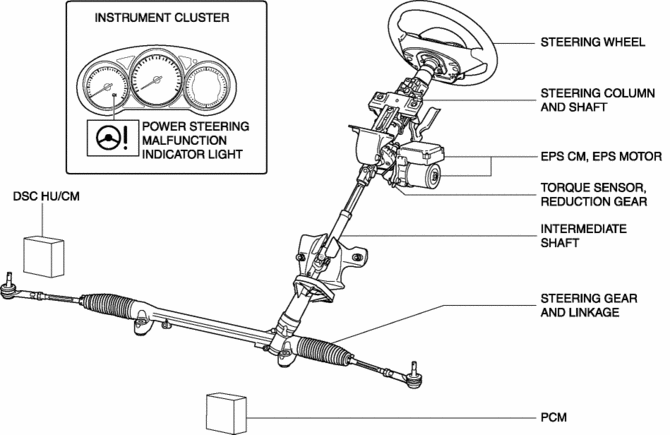Mazda CX-5 Service & Repair Manual: Electric Power Steering System
Outline
-
A column assist type EPS has been adopted for all models.
-
EPS provides smooth handling from low to high speeds as a result of the excellent steering feel provided by the electronic control and the vehicle-speed responsive control.
-
EPS does not require a power steering oil pump and generates assist force only when the steering wheel is steered. As a result, engine load is lowered and fuel efficiency is improved.
-
Serviceability improved by the automatic configuration function and the steering angle neutral position auto-learning function.
Structural View

System Wiring Diagram

Purpose/Function
-
The EPS assists the manual steering mechanism operation using the EPS motor to provide supplemental manual power during steering operation, reducing the load on the driver.
Construction
-
The EPS consists of the following parts:
-
Manual steering mechanism
-
Consists of the steering wheel, steering column, steering column and shaft, steering gear and linkage.
-
Electric assist mechanism
-
Consists of the EPS CM (control module) built in the steering column, torque sensor, reduction gear, and EPS motor integrated in the EPS CM.
-
Control system
-
Controls based on the EPS CM, torque sensor, reduction gear, EPS motor, and vehicle speed and engine speed signals input from the PCM.
Operation
1. Steering force generated by the driver's steering wheel operation is detected by the torque sensor which is built in the steering column and shaft, and is output to the EPS CM as a steering torque signal.
2. The EPS CM calculates optimum assist force based on the steering torque signal from the torque sensor and the vehicle speed and engine speed signals from the PCM, and outputs electric current to drive the EPS motor.
3. The EPS motor is driven by the current from the EPS CM and the force is transmitted to the intermediate shaft via the reduction gears, thus assisting steering operation of the driver.

 Electric Power Steering (Eps) Motor
Electric Power Steering (Eps) Motor
Purpose, Function
The EPS motor is driven by the control current from the EPS CM (control module)
and generates assist torque to manual steering mechanism.
Construction
The EPS ...
 Eps Control Module Inspection
Eps Control Module Inspection
1. Remove the driver-side front scuff plate..
2. Remove the driver-side front side trim..
3. Remove the car-navigation unit (with car-navigation system)..
4. Remove the switch panel..
5. Remov ...
Other materials:
Cruise Control System
Outline
Enables driving at a constant speed by setting the vehicle speed with the
cruise control switch instead of operating the accelerator pedal.
The PCM controls the throttle valve actuator to maintain the vehicle at a
constant speed.
Component and function
...
Charging System Warning Light [Skyactiv G 2.0]
Purpose, Function
Warns the driver of a charging system malfunction.
Construction
The charging system warning light is built into the instrument cluster..
Operation
Illuminates when a malfunction occurs in the charging system and DTCs is
stored in the PCM.
...
Up Switch Inspection [Fw6 A EL, Fw6 Ax EL]
Continuity Inspection
NOTE:
The up switch is built into the selector lever component.
1. Disconnect the negative battery cable..
2. Remove the front console..
3. Disconnect the selector lever component connector.
4. Verify that the continuity between selector lever component ...
